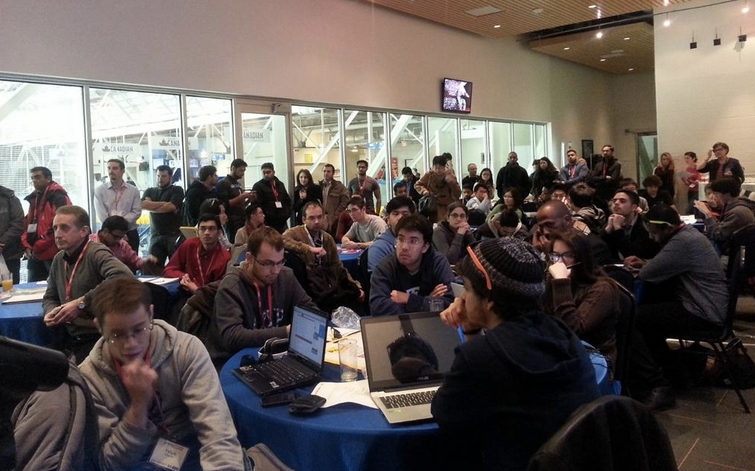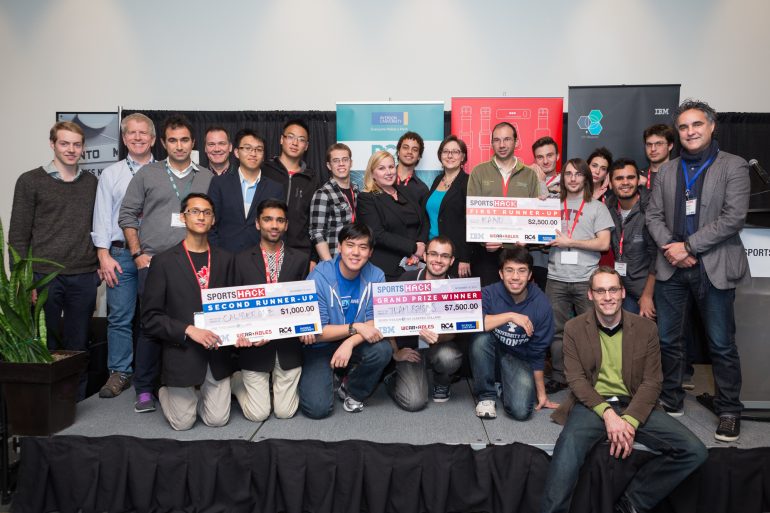“Hardware is just a case around the software today,” said Bruce Croxon, notable early-stage investor and former Dragon, this past Sunday. Croxon made the statement to a capacity crowd of 200 at SportsHack 2014, a joint venture between Ryerson University, IBM, and We Are Wearables.
The statement may seem incongruent at a wearables hackathon, and especially so considering that Croxon was a judge for the event. But Croxon’s message to the audience was clear: in 2014, the barrier of entry to building hardware technology is so low, and the cost so cheap, that the real battle will be on creating services that lock users in. “Because,” Croxon concluded, “the real money is in the data.”
36 hours of hacking taking place over a three-day period, SportsHack 2014 certainly gave proof to Croxon’s assertion that innovative wearable tech can be built quickly. Almost 20 teams, comprised mostly of sleepy-eyed university students, produced many quality proofs of concept that, with a bit more work, could find a home in the market. Thalamic, Kiwi, InteraXon, MeU, and IBM provided the tools to build, and mentors were on-hand to help the young but enthusiastic teams. Unlike other recent Toronto hackathons, most teams had no polish to their pitch, spending their weekends focused instead on product and punny team names (Team Raisins? The mind boggles).
The three finalist teams at SportsHack demonstrated the benefits of involving the next generation of entrepreneurs as early as possible.
The convergence of education and technology institutions with youthful hacker ethos was well-suited for an event taking place at Ryerson’s Mattamy Athletic Centre – formerly the Maple Leaf Gardens, itself a 20th century institution rebuilt for the 21st century. Speaking to Tom Emrich, We Are Wearables founder, BetaKit contributor (disclosure!), and MC for the event, the intersection of old and new was by design.
“What’s really fascinating is that IBM and Ryerson are established organizations that have proven technology and a wealth of experience in mass-market technology,” he told me. “Being able to pair that wealth of knowledge with emerging entrepreneurs is magical because it helps them to ramp up quicker and more easily than if they were attempting to build it themselves.”
“With Ryerson being involved in particular, it provides us the ability to tap into students and really young entrepreneurs right from the beginning to provide them the resources that are available and connect them with the startup community in Toronto.”

Emrich has shown recently that Toronto is a hot-bed of interest in sports and wearables, and the three finalist teams at SportsHack demonstrated the benefits of involving the next generation of entrepreneurs as early as possible. Runners-up Calibre One and KANU, who won $1,000 and $2,500 in prize money, respectively, provided two of the most ready-for-market solutions at the hackathon. First price winner Team Raisins’ innovative heat-mapping solution, however, which used bluetooth beacons and Moto 360 smartwatches to track player movements, had the largest market potential, and netted them the grand prize of $7,500, with ongoing support from IBM and RC4, plus a spot on stage at the upcoming We Are Wearables event. All finalists also received a boatload of wearable hardware from the participating sponsors.
Speaking to Team Rasins afterwards, it was clear they were a little overwhelmed and uncertain of their next move. But it was Croxon, after saying he must “pick his spots” when participating in such events, who summed up perfectly in his closing remarks the real outcome of SportsHack 2014: “youthful energy.”


